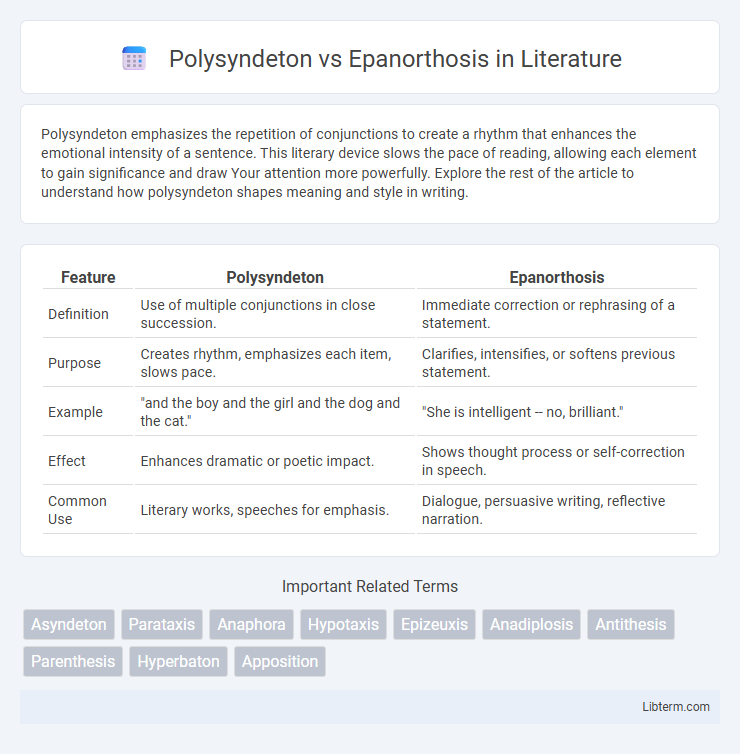Polysyndeton emphasizes the repetition of conjunctions to create a rhythm that enhances the emotional intensity of a sentence. This literary device slows the pace of reading, allowing each element to gain significance and draw Your attention more powerfully. Explore the rest of the article to understand how polysyndeton shapes meaning and style in writing.
Table of Comparison
| Feature | Polysyndeton | Epanorthosis |
|---|---|---|
| Definition | Use of multiple conjunctions in close succession. | Immediate correction or rephrasing of a statement. |
| Purpose | Creates rhythm, emphasizes each item, slows pace. | Clarifies, intensifies, or softens previous statement. |
| Example | "and the boy and the girl and the dog and the cat." | "She is intelligent -- no, brilliant." |
| Effect | Enhances dramatic or poetic impact. | Shows thought process or self-correction in speech. |
| Common Use | Literary works, speeches for emphasis. | Dialogue, persuasive writing, reflective narration. |
Understanding Polysyndeton: Definition and Examples
Polysyndeton is a rhetorical device characterized by the deliberate use of multiple conjunctions between words, phrases, or clauses to create a sense of rhythm and emphasis. Examples include phrases like "and," "or," and "but" repeated in a series, such as in the sentence "We have ships and men and money and stores." This technique enhances the emotional intensity and pacing of the text, making each element stand out distinctly.
Epanorthosis Explained: Definition and Usage
Epanorthosis is a rhetorical device used to immediately correct or refine a statement for emphasis or clarity, often following an initial imprecise or incorrect expression. This figure of speech enhances communication by signaling self-correction, making the speaker's intent more explicit and engaging the audience through dynamic discourse. Unlike polysyndeton, which involves the deliberate overuse of conjunctions to create rhythm or intensity, epanorthosis directly addresses and rectifies the message for stronger impact and precision.
Key Differences Between Polysyndeton and Epanorthosis
Polysyndeton involves the deliberate use of multiple conjunctions between clauses or items, creating a rhythmic and emphatic effect, while epanorthosis is the immediate self-correction or restatement of a word or phrase to intensify or clarify meaning. Polysyndeton enhances the pace and accumulation of ideas through repeated connectors like "and" or "but," whereas epanorthosis focuses on correcting or reinforcing a statement for precision or emphasis. The key difference lies in their function: polysyndeton links multiple elements cohesively, and epanorthosis refines or strengthens a former expression within discourse.
Semantic Impact of Polysyndeton in Writing
Polysyndeton enhances the semantic impact of writing by deliberately using multiple conjunctions to create a rhythmic, emphatic flow that slows the reader's pace and amplifies the weight of each element. This technique adds a sense of abundance, urgency, or overwhelming detail, intensifying the emotional resonance and emphasizing the significance of each listed component. By contrast, epanorthosis functions as a corrective device to refine or strengthen a preceding statement, whereas polysyndeton multiplies and magnifies meaning through conjunction-driven repetition.
The Rhetorical Power of Epanorthosis
Epanorthosis enhances rhetorical power by allowing speakers to immediately correct or refine their statements, heightening clarity and emphasis in communication. This figure of speech contrasts with polysyndeton, which relies on repeated conjunctions to create a cumulative effect rather than precise correction. Epanorthosis engages listeners by signaling thoughtful reconsideration, thereby strengthening persuasive impact and emotional intensity in discourse.
Function and Effect: Polysyndeton vs Epanorthosis
Polysyndeton employs repeated conjunctions to create a deliberate rhythm and emphasize the multiplicity of elements, often evoking a sense of abundance or urgency. Epanorthosis involves immediate self-correction to clarify or intensify a statement, enhancing precision and highlighting the speaker's reconsideration. Both devices manipulate sentence structure to shape tone and focus, with polysyndeton amplifying inclusivity and epanorthosis refining meaning.
Examples in Literature: Polysyndeton and Epanorthosis
Polysyndeton appears in literature through the deliberate overuse of conjunctions, as seen in Ernest Hemingway's "The Sun Also Rises," which states, "I want to eat and sleep and drink and be merry." Epanorthosis is exemplified in Shakespeare's "Hamlet" when Hamlet says, "I will not speak with her, yet I loved her once," correcting himself to enhance emotional effect. Both rhetorical devices enrich narrative texture by either emphasizing accumulation or refining meaning through self-correction.
Enhancing Emphasis: When to Use Polysyndeton or Epanorthosis
Polysyndeton enhances emphasis by deliberately using multiple conjunctions to create a rhythmic, cumulative effect that intensifies each listed element, making the sentence feel more expansive and dramatic. Epanorthosis strengthens emphasis through immediate self-correction or restatement, clarifying or intensifying a previous phrase to highlight its significance or precision. Use polysyndeton when you want to amplify the weight of each item in a series, and choose epanorthosis to draw attention to a corrected or heightened expression within your statement.
Common Mistakes: Polysyndeton vs Epanorthosis
Common mistakes when distinguishing polysyndeton from epanorthosis include confusing the repetitive use of conjunctions with immediate self-correction or clarification. Polysyndeton involves deliberately using multiple conjunctions for emphasis or rhythm, whereas epanorthosis is a rhetorical device where a speaker or writer corrects themselves mid-sentence. Misidentifying these can obscure the intended emphasis or correction, leading to misinterpretation of tone and style in literary or spoken analysis.
Tips for Writers: Mastering Polysyndeton and Epanorthosis
Polysyndeton enhances rhythm and emphasis by deliberately using multiple conjunctions in close succession, creating a dense, impactful effect that can heighten emotion or intensity in writing. Epanorthosis involves immediate self-correction or clarification, sharpening the message for clarity or rhetorical power. Writers should use polysyndeton to build momentum and reinforce ideas, while employing epanorthosis to refine statements or introduce nuance, balancing these techniques to maintain engagement without overwhelming readers.
Polysyndeton Infographic

 libterm.com
libterm.com